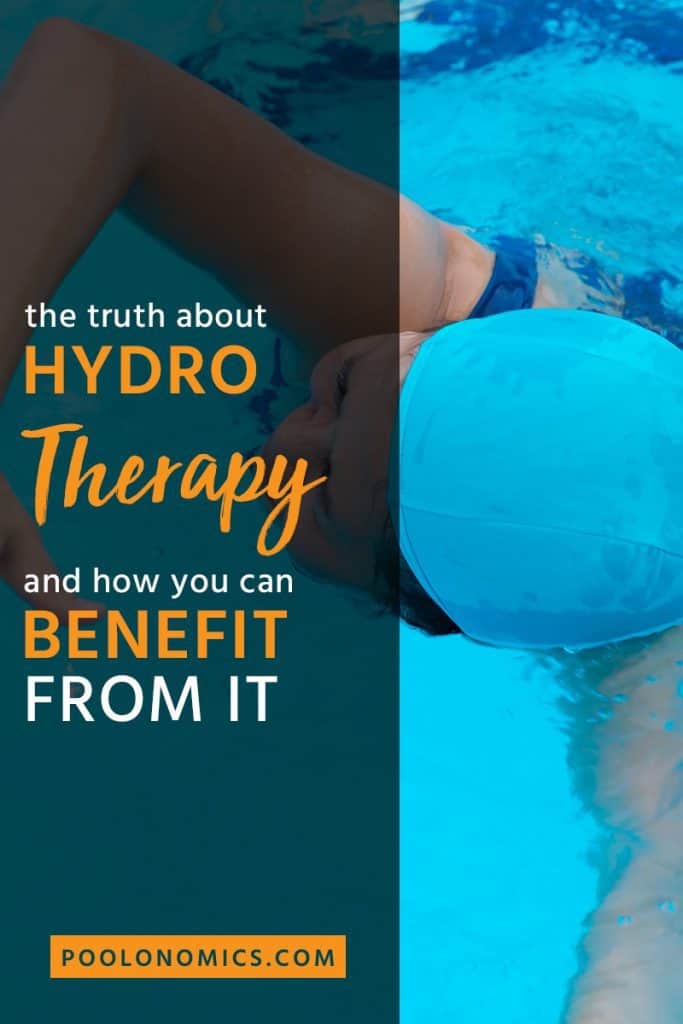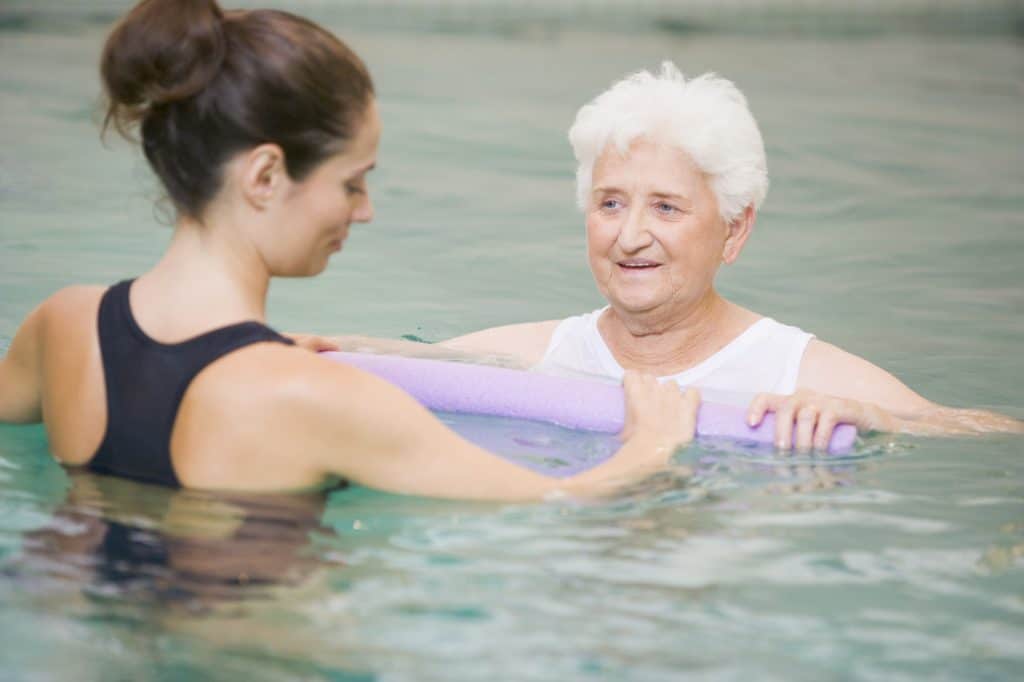It may sound technical, but hydrotherapy just means exercising in the water. Said to be one of the best ways to relieve all those aches and pains, it’s as useful as having physio in a pool!
You may think of exercising in the pool as something we all regularly do. I mean, surely swimming lengths by breaststroke and front and back crawl count as exercising in the pool, right?
Hydrotherapy is different as it involves the kind of workouts you see more of in gym classes.
Have you been thinking about giving hydrotherapy a go? Are you unsure if it’s for someone like you? Read on to find out more about its benefits.
What Is Hydrotherapy?
Hydrotherapy involves you standing in water, preferably which is up to your waist and working the areas of your body you feel the most pain in.
Now you may think that’s not the best idea to exercise parts of the body that cause you pain, but because you’re in the water, these movements are supported as the water acts as a resistance.
Hydrotherapy is said to be therapeutic and is often prescribed not just for physical pains but emotional ones too!
The practice can be traced all the way back to the Ancient Greeks, who believed water was an alternative to taking medicine and provided a more natural cure. So, it’s been around for some time now!
What Are The Benefits Of Hydrotherapy?
Hydrotherapy can help eliminate all those aches and pains, and all you need to do is get in the water, work on some stretches and movements and target those painful areas.
Think of it as the most relaxing massage you have ever had. This is usually how people feel once they’ve finished their hydrotherapy session. It’s like untangling all those niggly knots you’ve been unable to do before now.
Some people will feel tired after their session and others will feel fully charged and ready to go. Either way, you should be in less pain after getting out of the pool than what you were before getting in it!
When you place your full body weight into the water, you feel weightless. What is happening here is that the water is relieving your body of as much gravity as it can. The water then gentle works on your body, as though it is massaging and kneading it!
The smart part here though is how the water moves and touches the skin, stimulating it which increases your blood circulation and works on releasing and relaxing any tight muscles.
So, hydrotherapy is really all about the pressure and sensation of the water itself. When the nerves inside the body are exposed to this stimulus, they then work on reducing our body’s sensitivity towards pain.
It may seem as though you are just getting into the water and moving around for effect. But, if you consider what is going on inside of the body when you try hydrotherapy, it’s incredible just how much it works on kicking that pain to the sidewalk!
What Exactly Is Hydrotherapy Good For?
Hydrotherapy is the most natural way of treating pain by using the water. Used by many physiotherapists it can treat may symptoms such as:
- Arthritis
- Backache
- Headaches
- Migraine
- Muscle Pain
- Joint Replacements
- Inflammation
- Strokes
- Brain injuries
- Stress
- Sleeping Disorders
- Stomach Complaints
- Colds
- Depression
- Nerve Problems
- Blood Circulation Problems
- Diseases
- MS
As well as working to treat pain, it can also be used as a means of relaxing or even just to maintain good health, and building up strength after surgery. As you can see, there are so many possibilities involved.
You Don’t Need An Expensive Or Specialized Pool
Special pools do exist, but they aren’t essential if you want to try out hydrotherapy. You can have a go in any water and in any pool, all you need to do is move. The specialized pools are more for those who run dedicated hydrotherapy sessions on a regular basis.
Special hydrotherapy pools differ from regular pools because of their temperature, water pressure and the movement of the water. They can be controlled and changed to suit your needs. However, you don’t need to use one to get the benefits from hydrotherapy.
You will find many local pools offering sessions called aqua aerobics. This is another way of working on exercises in the pool to get rid of pain, while you have fun.
You can also do such exercises in lakes, pools and even the sea, as long as it’s calm and you’re safe. That’s the beauty of hydrotherapy; it can be done almost anywhere where there’s water.
So, now that we’ve worked out what it is and who it can help, where do we find the information to begin with those hydrotherapy exercises?
Hydrotherapy Exercises Are Easy To Master
Okay, before you get into that swimming costume or bathing trunks, you may want to check out a few simple moves to help you get started with hydrotherapy once you begin that first session.
There’s nothing worse than getting into the pool all worked up and ready to go and then wondering why you bothered because you have no idea of where to start.
Look at your session as a time to perform a few simple stretches, rather than arm and leg flinging dynamic movements!
You can do many different types of these movements and target many different areas. The most popular are those that target the lower body, the knees and the lower back.
By watching others perform the movements, you will get the idea after just a couple of sessions and soon become an expert on them.
Over time you’ll be able to work out which one works best for you and your pain threshold. The whole point of these exercises is to make sure they are low in impact.
Can’t Swim? No Problem.
There are many myths about hydrotherapy, and the biggest one is that you can’t do it if you can’t swim. This is a lie. If you can touch the floor and stand up in the water, you don’t need to be a competent swimmer.
You may want to stand closer to the edge of the pool for added security but otherwise, if you have no fear of the water, being a non-swimmer will not stop you getting the benefits of hydrotherapy.
If you would prefer to be near professionals when attempting hydrotherapy, you should have no problems finding local sessions. These will make sure someone is in the pool with you at all times, giving you that little bit more confidence as you practice those moves.
In fact, if you are one of those people who needs to have hypnotherapy as part of a recovery, you will most likely do this with a group of people in the pool.
Make sure you try hydrotherapy in a place where you feel the most comfortable. After all, the whole point of it is to relax those muscles. That is something you can’t try to do if you are worried about being in the water alone!
Common Myths About Hydrotherapy
“But isn’t hydrotherapy just swimming?”
This is often said when you tell people you are doing hydrotherapy. In fact, it is not just swimming because its main purpose is to concentrate on a particular area and get rid of your pain.
“Don’t you have to be a professional to do hydrotherapy?”
Another idea people have about this is that you can’t try hydrotherapy unless you have a hydrotherapy qualification of some sort.
As long as you perform the exercises carefully and you listen to your body, you do not need any qualifications to attempt hydrotherapy.
“I thought only people with movement problems needed hydrotherapy?”
Again, some people have only heard of this being used to treat those recovering from joint problems. There’s no rules that say only a few can benefit from hydrotherapy. Young or old it is something anybody can choose to try out.
As many people don’t know what hydrotherapy is, or what it involves, they will make up their own stories about it all. If someone insists on putting you off it, just ask them when was the last time he or she tried hydrotherapy?
That’s usually enough to stop the comments!
Are You Ready To Give Hydrotherapy A Go?
You may have heard of dogs now getting in on the hydrotherapy act? Yep, that’s right, hydrotherapy for dogs is becoming popular with many owners. Once again it uses the same ideas as human hydrotherapy and has the same pain-relieving effects as well.
It seems that the professionals have realized that this method is not just good for humans but for canines as well!
So, now that you’ve read about the many benefits why not give hydrotherapy a go yourself? Even if you don’t have any aches or pains to complain about, why not see what it could do for you?
If it was good enough for the Greeks, Romans, and Egyptians, and is now a favorite with dogs too, hydrotherapy is surely good enough for us as well!
Share on Pinterest




